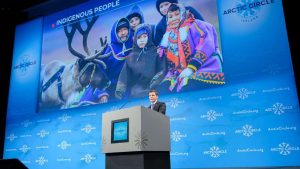OCTOBER 13, 2019

SWEDEN – Melting ice is opening access to new energy resources faster than predicted, prompting a nascent great power struggle in the Arctic as the political and economic map of the world is transformed.
That, at least, is one picture that’s being sharply drawn at this weekend’s Arctic Circle Assembly in Iceland, a kind of Davos for the far north. The seven-year-old event is the largest annual forum for politicians, scientists, environmentalists and others to talk about the Arctic, including climate change, security and the exploitation of new oil and gas discoveries.
U.S. Energy Secretary Rick Perry called for “free nations” to resist attempts from those “that seek to dominate the Arctic from the outside,” an apparent reference to China, which calls itself a “near Arctic” power. Speaking at Thursday’s opening session, he also warned against countries trying to do the same through energy sales, an oblique dig at Russia.
Yet the attempt to rally U.S. allies faces an uphill battle as the Arctic emerges as a potential 21st century geopolitical flashpoint in the way transportation routes like the Suez Canal were in the 20th.
Perry was followed on stage by Dmitry Artyukhov, the governor of the Yamal-Nenets region in Russia. He spelled out the growing international involvement in his region’s new and planned liquefied natural gas fields.
In the three years from 2016 to 2018, these have quadrupled Russia’s share of the global LNG market to 8%, from 2%, with much more growth to come. Investors so far include Total SA of France, CNOOC Ltd. and China National Petroleum Corp. of China, and Mitsui & Co. and Japan Oil, Gas and Metals National Corporation, of Japan. Further projects are already approved.
South Korea, meanwhile, is building ice-hardened LNG supertankers to ship the gas, at more than $300 million apiece. They can only deliver to Asia when Russia’s Northern Sea Route is relatively ice free. Still, this year it became navigable in August and traffic is still passing in October. The time-frame for when the passage will be consistently ice free is shrinking all the time.
 Crown Princess Victoria Of Sweden attends The Arctic Circle Assembly. – Getty Images
Crown Princess Victoria Of Sweden attends The Arctic Circle Assembly. – Getty Images
Artyukhov was followed by a double act of diplomats from China and U.S. treaty ally South Korea, who talked about their tight trilateral cooperation on Arctic affairs with another U.S. treaty ally, Japan.
Asked if China might stop calling itself a near Arctic state in the light of U.S. opposition, Gao Feng, special representative for Arctic affairs in China’s foreign ministry, said simply: “No.”
“We see the emergence in front of our eyes of a new economic, business and political map,” said former Iceland President Olafur Ragnar Grimsson, who founded and chairs the Arctic Circle Assembly.
“What is happening now is first, the emergence of Asia as the leading source of economic growth in the 21st century, and second, the opening up of the Arctic which, combined with new technologies, is creating access to the oil and gas to supply that growth,” he said in an interview just ahead of the conference in the Icelandic capital Reykjavik.
That emerging new world order was mapped out in a slide show on Friday morning by Henry Tillman, who runs Grisons Peak LLP, a London-based investment bank, and its research arm, China Investment Research. Projected onto the conference hall’s giant screen, he called it “Paving the Polar Silk Road.”
The Polar Silk Road is part of China’s Belt and Road Initiative and aims to reduce its trade logistics costs. Not only is the Northern Sea Route much shorter than current energy shipping lanes to Asia via the Indian Ocean and Suez Canal, there’s also less political risk, Tillman said. There’s nothing like the Strait of Hormuz in the Gulf, for example, where tension with Iran has escalated.
The U.S. has ambitions of its own to become one of the world’s leading LNG exporters. It’s projected to be producing 100 million tons of LNG by 2024, to Russia’s 63 million tons, but could face higher extraction and transport costs to get to export markets in Asia and Europe, according to Tillman.
That explains the aggressive stance the U.S. has taken against a planned natural gas pipeline from Russia to Europe and toward Russia and China’s activities in the Arctic, said Grimsson, Iceland’s president from 1996 to 2016.
Shawn Bennett, deputy assistant secretary for oil and natural gas at the Department of Energy, said the U.S. was not concerned about competition. Growth projections for natural gas demand in India and other Asian countries are so high, and the need for supply diversification in Europe so acute that there’s little risk of a glut, he told Bloomberg. “Global demand for LNG is just going to grow,” he said.
 The U.S. may be pushing back in more concrete ways. On September 30, the Department of the Treasury imposed sanctions on units of China’s Cosco Shipping Corp., over alleged breaches of U.S. sanctions against Iran. The move immediately hit the Yamal project’s LNG tanker routes because of Cosco’s share in one of the main shipping companies involved.
The U.S. may be pushing back in more concrete ways. On September 30, the Department of the Treasury imposed sanctions on units of China’s Cosco Shipping Corp., over alleged breaches of U.S. sanctions against Iran. The move immediately hit the Yamal project’s LNG tanker routes because of Cosco’s share in one of the main shipping companies involved.
Still, for those who have been working in the Arctic for a long time, much of the geopolitical discussion sounds a little breathless. Last year, Russia’s Northern Sea Route carried 29 million tons of cargo, with projections rising to 90 million. The Suez Canal carries about 1 billion tons.
Ice floes are unpredictable even when retreating, and insurable risks for shipping through the polar ice can be significantly higher than in warmer seas, according to Janne Valkonen, who specializes in engineering ships and oil rigs for cold weather at DNV GL Group, a provider of maritime risk services.
“Disputes, race, scramble – stop using these terms,” said Liv Monica Stubholt, a Norwegian lawyer with the firm Selmer AS, who advises companies on Arctic issues “There is no scramble for the Arctic. The biggest problem my clients have is attracting investment.”










































































































